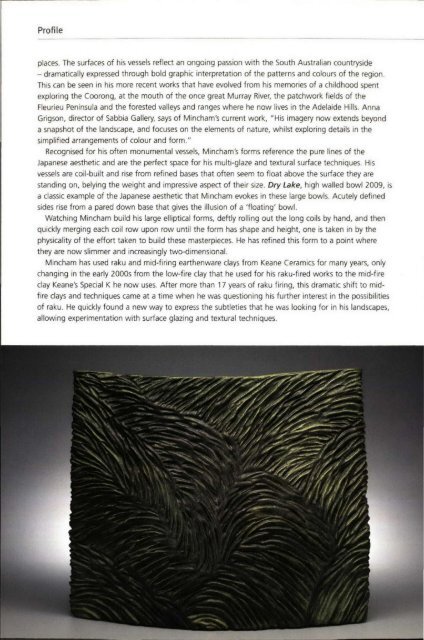The Journal of Australian Ceramics Vol 48 No 3 November 2009
You also want an ePaper? Increase the reach of your titles
YUMPU automatically turns print PDFs into web optimized ePapers that Google loves.
Pr<strong>of</strong>ile<br />
places. <strong>The</strong> surfaces <strong>of</strong> his vessels reflect an ongoing passion with the South <strong>Australian</strong> countryside<br />
- dramatically expressed through bold graphic interpretation <strong>of</strong> the patterns and colours <strong>of</strong> the region .<br />
This can be seen in his more recent works that have evolved from his memories <strong>of</strong> a childhood spent<br />
exploring the Coorong, at the mouth <strong>of</strong> the once great Murray River, the patchwork fields <strong>of</strong> the<br />
Fleurieu Peninsula and the forested valleys and ranges where he now lives in the Adelaide Hills. Anna<br />
Grigson, director <strong>of</strong> Sabbia Gallery, says <strong>of</strong> Mincham's current work, "His imagery now extends beyond<br />
a snapshot <strong>of</strong> the landscape, and focuses on the elements <strong>of</strong> nature, whilst exploring details in the<br />
simplified arrangements <strong>of</strong> colour and form."<br />
Recognised for his <strong>of</strong>ten monumental vessels, Mincham's forms reference the pure lines <strong>of</strong> the<br />
Japanese aesthetic and are the perfect space for his multi-glaze and textural surface techniques. His<br />
vessels are coil-built and rise from refined bases that <strong>of</strong>ten seem to float above the surface they are<br />
standing on, belying the weight and impressive aspect <strong>of</strong> their size. Dry Lake, high walled bowl <strong>2009</strong>, is<br />
a classic example <strong>of</strong> the Japanese aesthetic that Mincham evokes in these large bowls. Acutely defined<br />
sides rise from a pared down base that gives the illusion <strong>of</strong> a 'floating' bowl.<br />
Watching Mincham build his large elliptica l forms, deftly rolling out the long coils by hand, and then<br />
quickly merging each coil row upon row until the form has shape and height, one is taken in by the<br />
physicality <strong>of</strong> the effort taken to build these masterpieces. He has refined this form to a point where<br />
they are now slimmer and increasingly two-dimensional.<br />
Mincham has used raku and mid-firing earthenware clays from Keane <strong>Ceramics</strong> for many years, only<br />
changing in the early 2000s from the low-fire clay that he used for his raku-fired works to the mid-fire<br />
clay Keane's Special K he now uses. After more than 17 years <strong>of</strong> raku firing, this dramatic shift to midfire<br />
clays and techniques came at a time when he was questioning his further interest in the possibilities<br />
<strong>of</strong> raku . He quickly found a new way to express the subtleties that he was looking for in his landscapes,<br />
allowing experimentation with surface glazing and textural techniques.


















